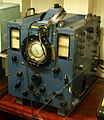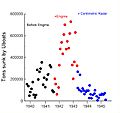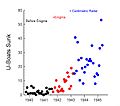Battle of the Atlantic facts for kids
Quick facts for kids Battle of the Atlantic |
|||||||
|---|---|---|---|---|---|---|---|
| Part of the Second World War | |||||||
 Officers on the bridge of an escorting British destroyer stand watch for enemy submarines, October 1941 |
|||||||
|
|||||||
| Belligerents | |||||||
|
List
|
|||||||
| Commanders and leaders | |||||||
| Casualties and losses | |||||||
| 36,200 sailors killed 36,000 merchant seamen killed 3,500 merchant vessels 175 warships 741 RAF Coastal Command Aircraft lost in anti-submarine sorties |
783 submarines lost 47 other warships lost 17 submarines lost |
||||||
The Battle of the Atlantic was the longest continuous military campaign of World War II. It lasted from 1939 until Germany was defeated in 1945. This battle was a huge part of the naval history of World War II.
At its heart, the battle was about the Allies trying to stop Germany from getting supplies by sea. Germany then tried to do the same to the Allies. The most intense fighting happened from mid-1940 to the end of 1943.
Contents
What was the Battle of the Atlantic?
The Battle of the Atlantic was a fight between German U-boats (submarines) and other warships of the German Kriegsmarine (Navy). German Luftwaffe (Air Force) planes also took part. They fought against the Royal Navy (British Navy), Royal Canadian Navy, United States Navy, and Allied merchant ships.
Ships carrying supplies, mostly from North America, sailed to the United Kingdom and the Soviet Union. These groups of ships, called Convoys, were mainly protected by British and Canadian navies and air forces. Ships and planes from the United States joined them starting in September 1941. Germany was joined by submarines from the Italian Regia Marina (Royal Navy) after Italy joined the war in June 1940.
Why was this battle so important?
The United Kingdom is a small island country. It needed more than a million tons of imported goods every week to survive and keep fighting. The Battle of the Atlantic was the Allies' struggle to make sure Britain got these vital supplies.
From 1942 onwards, Germany and Italy also tried to stop the Allies from building up supplies in the British Isles. These supplies were needed for the planned invasion of occupied Europe. It was very important to defeat the U-boat threat to push back the Axis forces in Western Europe.
The Allies won the battle. Germany's plan to block supplies failed. But it came at a high cost. About 3,500 merchant ships and 175 warships were sunk in the Atlantic. The Germans lost 783 U-boats and 47 other warships. About 36,200 Allied sailors and 36,000 merchant seamen died. Around 30,000 German U-boat sailors were killed.
How did the Allies win?
The Battle of the Atlantic is known as the "longest, largest, and most complex" naval battle in history. It lasted over five years, until Germany surrendered in May 1945.
Thousands of ships were involved in more than 100 convoy battles. There were also about 1,000 fights between single ships. The battle covered millions of square miles of ocean. The situation kept changing. One side would gain an advantage, then the other. New weapons, tactics, and equipment were developed by both sides.
The Allies slowly gained the upper hand. They defeated German surface ships by the end of 1942. They largely defeated the U-boats by mid-1943. However, U-boat attacks continued until the war ended.
Interesting Facts About the Battle
- The Battle of the Atlantic was important because it was about controlling the Atlantic Ocean.
- About 100 convoy battles took place during the war.
- It was called the "longest, largest, and most complex" naval battle in history.
- New technology and teamwork between the Navy and Air Force helped the Allies win.
- The Allies had broken the German codes. This meant they could read German secret messages.
- They also had radar to find German ships.
- Planes were fitted with searchlights to see German U-boats on the surface at night.
- Black May in 1943 was a turning point. During this month, German U-boats lost more ships than the Allies did.
- German U-boats sank almost 5,000 Allied ships during the war.
Images for kids
-
Grand Admiral Erich Raeder with Otto Kretschmer (left), August 1940
-
Before Murmansk Seaport began operating as a hub for arctic convoys, it has been offered by Stalin to Hitler as a secret submarine base for German U-boats at the climax of the Battle of the Atlantic
-
German submarine pens in Lorient, Brittany
-
The battlecruiser HMS Hood steaming into battle minutes before she was sunk by the German battleship Bismarck on May 24, 1941.
-
A SB2U Vindicator scout bomber from USS Ranger flies anti-submarine patrol over Convoy WS-12, en route to Cape Town, November 27, 1941. The convoy was one of many escorted by the US Navy on "Neutrality Patrol", before the US officially entered the war.
-
Leigh Light fitted to a Royal Air Force Coastal Command Liberator, February 26, 1944
-
U-459, a Type XIV supply submarine (known as a "milch cow") sinking after being attacked by a Vickers Wellington
-
Seamen raise the White Ensign over the captured German U-boat U-190 in St. John's, Newfoundland 1945
See also
 In Spanish: Batalla del Atlántico para niños
In Spanish: Batalla del Atlántico para niños
























